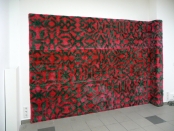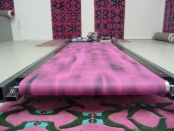CHINA_SPEED, design treadmill (180 x 68 cm)
introduction: GOBO_LINE: Tilmann Spengler
text: GOBO_LINE: Dr. Cornelia Oßwald-Hoffmann
BLOCK 40 x 30 x 80 cm at home of some visitors
Installation by Michaela Rotsch, E324 – Munich, 2010
Supposing that everything can be art; supposing that every found object can become art by the context it’s placed in; supposing that the artwork is a work structure consisting of a concept and work process in which the products produced make up a materials cache for further materializing, visualizing, and thought processes—then a trifling occasion, a meaningless snippet may suffice to initiate a globally networked and ongoing artwork, suffice to observe its worldwide dissemination, to allow interventions to redirect and re-formulate it.
The origin of Michaela Rotsch’s GOBO_LINE is an intermediate space between two actors from the film “Gattaca” (->Start) where—from an invisible micro-domain—perfect people are created in a perfect architecture within perfect environs. This film snippet, first visible in a movie still, is actually immaterial. Not till the artist cuts it out to make it into a two-dimensional object does it take on material existence. What label can you give such an artwork that proceeds from such a situation? This work structure, set up on a global scale, is thus created from a placeless whateverism, an immaterial germ cell. –> arabesque modular designs
Once in existence, Rotsch determines the parameters by the blocks of patterns that are compiled from the snippets from different groups of participants. Since craftsmanship is an authorized essential factor, a certain variable but foreseeable latitude is left for the participants’ particular individuality. Each one incorporates his/her own personality according to the way they cut out the snippet and how each places it in the predetermined system.
Each product is an interpretation of Rotsch’s predeterminations, which are diversified according to different possibilities.
The arabesquely organized structure of the work is manifest in this line of action. From antiquity on, the arabesque — in western as well as eastern cultural circles — has stood for the principle of “the gap and the circuitous” as well as “adaptation and divergence”. In the work process, the basic precept is not deployed linearly, but evolves in circulating movements and constantly new approaches. Once initiated, the snippet is reproduced and resembles a diagram showing the exponential growth in a global “market economy”. From their European place of origin, the artist’s “arabesque pattern modules” are transferred to other continents and intermeshed with other cultures: the fine-art painting tradition of the occident with the tradition of Islamic Morocco from the Atlas Mountains (Ait Bougmez), (->ATLAS/MAROC – TEXTIL), that of Confucian and Taoist China (Shanghai) (->SHANGHAI/CHINA_TEXTIL) , and of Hinduism in western India (Ahmedabad) (->AHMEDABAD/INDIA_TEXTIL). Different varieties of textile production are hereby chosen: from the individual handicraft in the Atlas Mountains, by way of the masterly copy of workshop skill in India, to the machine fabrication in China—all of which leads to various kinds of divergence from the preset pattern. Via mechanical execution, these are minimal, since a best possible implementation of the model has priority, but at the same time the template is simplified and thus abstracted. During the individual work by hand, the prototype is maximally diversified as the weavers take up their own, traditional range of patterns in an adapted form. This “new pattern” allows self-creations to arise that breach the project’s controlled framework and propels the project into the pioneering space of a new cultural form.
From this point, the artist continues to work on two levels. On the one hand, she prompts others from different cultural spheres to go on working with their own available modules and then meshes the results with those from other cultural spheres and places. (->MUSTER_PRODUKTION; ->TAGGED IMAGES; ->BEILÄUFIG.) On the other hand, in actions and exhibitions she constantly goes back to her original module and its revised forms and develops it further at site-specific locations. (->INSTALLATIONEN_RÄUME)
In GOBO_LINE she combines these two levels. The artist re-appropriates the products from other players as material for her own work and arranges them into a coherent installation over two floors at “E324 – Raum für Kunst”.
GOBO_LINE is all about planes, lines and paths within a space. The carpet as a “runner” in a room implements the dynamic movement of the line. On the upper floor the wall is instrumentalized as a support for the “textile pattern blocks”. In the room lined with carpeting a video loop shows the legs of a runner on a motorized treadmill on which a patterned rug or “runner” is spanned that, when speeded up, blurs the rug pattern to a dynamic colored picture plane. This stage of the ongoing project’s materialization reclaims the pictorial from the three-dimensional textile which, for its part, was a further development of the two-dimensional pattern that, for its part, was derived from an immaterial snippet of an ostensibly three-dimensional cinematic blank space.
The staircase wall leads the horizontal movement in the upper room down to a further block of “textile pattern” in the lower room. It is here that the viewer finds the actual treadmill carpeted with a “pattern block”, the noise of whose motor resounds through the entire exhibition. The walls are filled, almost flooded, with rugs primarily from China. The treadmill runs at “chinaspeed”, as the people from Shanghai call their own fast-paced lifestyle. The masses of “pattern blocks” produced there, driven by the speed of the machine, engulf the products from other places. Only the Indian “runner” that Rotsch mounted on its own wall offers a point of tranquility in this otherwise profusely emblazoned movement.
Michaela Rotsch studied painting at the Munich Academy of Fine Arts as well as in the visual media master class of Prof. Peter Weibel in Vienna. She wrote her dissertation on arabesque organizational structures in painting and film under Prof. Dr. Bazon Brock at Wuppertal University. Her work process is defined by interdisciplinary, intermedial and intercultural projects as well as by installations. These in turn generate process-oriented organizational structures that create room for future thoughts, actions and productions.
Dr. Cornelia Osswald-Hoffmann, April 2010
From the German by Jeanne Haunschild












One Comment
Thanks for a great opening last Friday, Michaela! The photos will be posted on the website today (www.E324.de). Have a great start into the week.